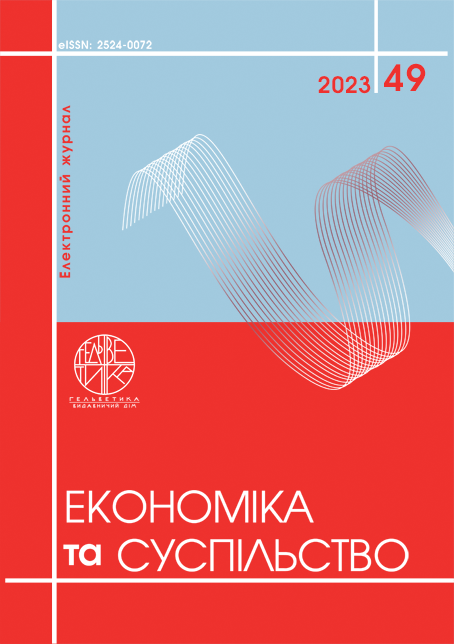CURRENT STATE AND DYNAMICS OF GLOBAL INTEGRATION PROCESSES
Abstract
International integration processes show to be an important factor of transformations in global economy under current globalization trends. Integration has penetrated into all spheres of human activity and exerts a continuous influence on them. The interdependence of the economic systems of individual countries is deepening, the influence of global processes on internal economic mechanisms is intensifying, and the vulnerability of national economies is increasing. All this gives rise to the need for the formation of an effective foreign economic policy and a mechanism for minimizing the potential negative consequences of international integration, which substantiates the relevance of this study. International integration is a process of deepening relations between countries and business entities in order to achieve common interests. The process of international integration is one of the main driving forces of scientific and technical development and progress in the field of innovation. The assessment of the current state of involvement of the countries into international integration demonstrates that the dynamics of deepening interstate cooperation is characterized by positive trends, i.e. the number of concluded multilateral agreements continues to grow, new regional associations are formed, and existing integration blocs are expanding. Over the past two decades, the number of signed regional preferential trade agreements has increased four times. Notable trends in recent years are the intensification of integration processes between the countries of the African continent, as well as the states of the Middle East, which contributed to the formation of the East African Community, the Economic Community of Central African States, the West African Economic and Monetary Union, and the Gulf Cooperation Council. Each integration group is an important part of the global economy that causes the need to study the indicators of their activity. Not only have the dynamics of international integration undergone changes, but also directly the performance indicators of individual integration entities. The majority of integration associations are characterized by positive trends in the growth of export-import operations, the level of GDP and indicators of the quality of life of the population. There is an intensification of economic interaction not only within individual groups, but also within their cooperation with other integration entities.
References
Regional Trade Agreements Database 2022. World Trade Organization. URL: http://rtais.wto.org/UI/charts.aspx (дата звернення: 08.04.2023).
Global preferential trade agreements database. The World Bank. URL: https://wits.worldbank.org/gptad/library.aspx (дата звернення: 08.04.2023).
Customs unions. Trade agreements and trade arrangements. The European Commission. URL: https://trade.ec.europa.eu/access-to-markets/en/content/customs-unions (дата звернення: 09.04.2023).
Gross domestic product (GDP) 2022. Organisation for Economic Cooperation and Development. URL: https://data.oecd.org/gdp/gross-domestic-product-gdp.htm (дата звернення: 09.04.2023).
Population and Vital Statistics Report. Department of Economic and Social Affairs. Statistical Papers. 2022. Series A. Vol. LXXIV.
The World Economic Outlook Report. 2021. April Edition. International Monetary Fund. URL: https://www.imf.org/en/Publications/WEO/weo-database/2021/April (дата звернення: 09.04.2023).
Real GDP 2022. International Monetary Fund. URL: https://www.imf.org/external/datamapper/NGDPD@WEO/OEMDC/ADVEC/WEOWORLD (дата звернення: 20.04.2023).
Gross domestic product 2021. The World Bank. URL: https://www.worldbank.org/en/search?q=world+GDP¤tTab=1&x=0&y=0 (дата звернення: 20.04.2023).
Indicators of world development: population dynamics. The World Bank. URL: http://wdi.worldbank.org/table/2.1 (дата звернення: 20.04.2023).
Quality of Life Index by Country 2022. Numbeo global database. URL: https://www.numbeo.com/quality-of-life/rankings_by_country.jsp (дата звернення: 21.04.2023).
Hamadeh N., Rompaey C., Metreau E. World Bank country classifications by income level: 2021-2022. Development Data Group. The World Bank. URL: https://blogs.worldbank.org/opendata/new-world-bank-country-classifications-income-level-2021-2022 (дата звернення: 21.04.2023).
World Development Indicators: The World by Income and Region. The World Bank. URL: https://datatopics.worldbank.org/world-development-indicators/ the-world-by-income-and-region.html (дата звернення: 21.04.2023).
Quality of Life Index by Country 2022. Numbeo global database. URL: https://www.numbeo.com/quality-of-life/rankings_by_country.jsp (дата звернення: 25.04.2023).
Global dynamics of merchandise export. World Trade Organization. URL: https://data.worldbank.org/indicator/TX.VAL.MRCH.CD.WT?end=2021&most_recent_year_desc=false&start=1960&view=chart (дата звернення: 25.04.2023).
The United Nations Comtrade database: global trade data. United Nations Statistics Division. URL: https://comtradeplus.un.org/ (дата звернення: 23.04.2023).
International trade between countries. Website of Observatory of Economic Complexity. URL: https://oec.world/en (дата звернення: 26.04.2023).
Regional trade agreement database. World Trade Organization. URL: http://rtais.wto.org/UI/PublicSearchByMemberResult.aspx?MemberCode=840&lang=1&redirect=1 (дата звернення: 27.04.2023).
Regional Trade Agreements Database (2022). World Trade Organization. Retrieved from: http://rtais.wto.org/UI/charts.aspx
Global preferential trade agreements database. The World Bank. Retrieved from: https://wits.worldbank.org/gptad/library.aspx
Customs unions. Trade agreements and trade arrangements. The European Commission. Retrieved from: https://trade.ec.europa.eu/access-to-markets/en/content/customs-unions
Gross domestic product (GDP) (2022). Organisation for Economic Cooperation and Development. Retrieved from: https://data.oecd.org/gdp/gross-domestic-product-gdp.htm
Population and Vital Statistics Report (2022). Department of Economic and Social Affairs. Statistical Papers, Series A. Vol. LXXIV.
The World Economic Outlook Report (2021). April Edition. International Monetary Fund. Retrieved from: https://www.imf.org/en/Publications/WEO/weo-database/2021/April
Real GDP 2022. International Monetary Fund. Retrieved from: https://www.imf.org/external/datamapper/NGDPD@WEO/OEMDC/ADVEC/WEOWORLD
Gross domestic product 2021. The World Bank. Retrieved from: https://www.worldbank.org/en/search?q=world+GDP¤tTab=1&x=0&y=0
Indicators of world development: population dynamics. The World Bank. Retrieved from: http://wdi.worldbank.org/table/2.1
Quality of Life Index by Country 2022. Numbeo global database. Retrieved from: https://www.numbeo.com/quality-of-life/rankings_by_country.jsp
Hamadeh N., Rompaey C., Metreau E. Worl d Bank country classifications by income level: 2021-2022. Development Data Group. The World Bank. Retrieved from: https://blogs.worldbank.org/opendata/new-world-bank-country-classifications-income-level-2021-2022
World Development Indicators: The World by Income and Region. The World Bank. Retrieved from: https://datatopics.worldbank.org/world-development-indicators/the-world-by-income-and-region.html
Quality of Life Index by Country 2022. Numbeo global database. Retrieved from: https://www.numbeo.com/quality-of-life/rankings_by_country.jsp
Global dynamics of merchandise export. World Trade Organization. Retrieved from: https://data.worldbank.org/indicator/TX.VAL.MRCH.CD.WT?end=2021&most_recent_year_desc=false&start=1960&view=chart
The United Nations Comtrade database: global trade data. United Nations Statistics Division. Retrieved from: https://comtradeplus.un.org/
International trade between countries. Website of Observatory of Economic Complexity. Retrieved from: https://oec.world/en
Regional trade agreement database. World Trade Organization. Retrieved from: http://rtais.wto.org/UI/PublicSearchByMemberResult.aspx?MemberCode=840&lang=1&redirect=1

This work is licensed under a Creative Commons Attribution 4.0 International License.


